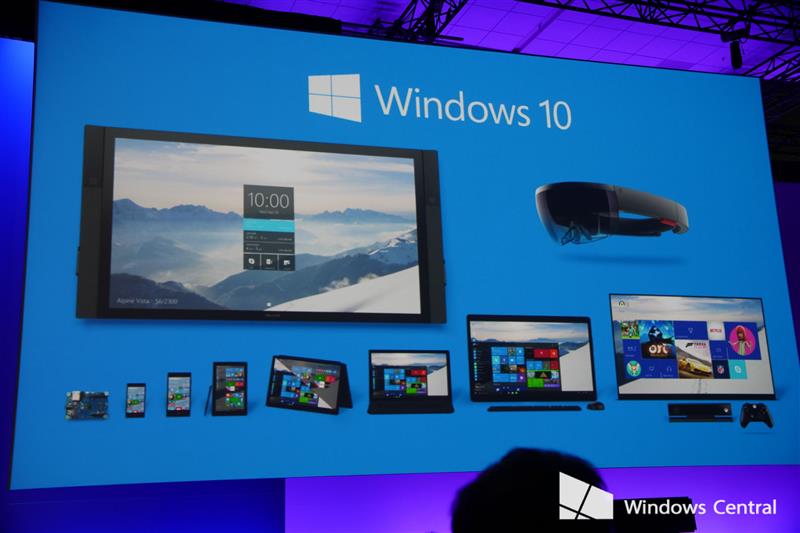Windows 10 desktop will come out before Phone in a staggered release cycle

Earlier today at Build, Microsoft held a special gathering of media and journalists to meet with some of the Windows leadership team. The purpose of the event was less formal, and more of a chance to interact with and ask questions. As such, video and photos were discouraged.
To kick off the nearly two-hour event, Microsoft's Joe Belfiore gave an introductory talk about some aspects of Windows 10 not yet widely known. One of those was in regards to the planned release cycle of Windows 10 updates and new hardware, including the phone.
For a few months now, Microsoft has been claiming that Windows 10 would be released "this summer". However, the status of Windows Phone in that release was not made too clear. Today we learned that, as many have guessed, Windows Phone will come out a bit later. Belfiore would not commit to a more definitive time frame, although it did not sound like it was that much later.
Indeed, we could be talking only a few weeks here, as this was intimated by Belfiore in his comments. What Microsoft is not promising at this time is a same-day release for everything. Fair enough.

Reasons for a staggered release
For those in the Windows Insider program, it should be obvious that Windows 10 for desktop is released earlier than the Windows Phone version by a few weeks and ahead by numerous builds. This discrepancy translates into the resultant staggered release plan for Windows 10 after the desktop version goes out.
Microsoft is targeting desktop first because it is their largest number of users when compared to phone customers. From that perspective, hitting your biggest group first makes total sense when devoting resources. This delay is not to say they find phone less important, certainly not. These are just the realities of making a unified operating system.
HoloLens, Surface Hub, and Xbox One were also on that list of coming later on, presumably this year. The good news here is Microsoft can use these staggered updates and releases to keep their achievements in the tech news cycle for the rest of the year. It also takes some pressure off of trying to line up such massive releases for all systems on the same day.
All the latest news, reviews, and guides for Windows and Xbox diehards.
Windows Insider program will continue
Some good news though is that the Microsoft preview program dubbed Windows Insider will continue beyond the RTM release of Windows 10.
Fast ring and slow ring will be the options, at least for now. Those on the fast ring are likely looking at two updates a month to try out new features before they go to slow ring, and then pushed in the main build.
In speaking with Microsoft's Gabriel Aul, also in attendance, he said they are still considering adding more 'rings' to the Windows Insider program. One ring may be 'finalized by not yet approved for public release'. This proposed ring is analogous to the Preview for Developers program, which released finalized builds of the OS before carriers had their approval. So this would be slower than Slow ring, but faster than the public version.
Another Windows Insider ring that still may see the light of day would be a 'ludicrous ring' for daily builds. Aul notes the data gathered from these releases would be very useful to his team, who could do more A-B testing to get feedback from users. However, there are clearly greater risks too.

The takeaway
For many weeks now, I have been saying the Windows Phone version of Windows 10 won't be ready for a while. The rawness of the current previews testifies to that fact. However, Microsoft has some bigger releases coming in May, and I think you will be surprised at how fast Windows 10 for mobile cleans up and become more coherent.
For Microsoft, these raw builds are normal. However, for customers, it's a new jarring experience. But in speaking with Microsoft today, they are very confident that this will all pull together over the next few months, and I for one believe them.
More importantly, we need to change our mindset. Windows 10 is never going to be 'final'. Sure, there will be an RTM flight to OEMs for release, but the point here is to think of Windows as a Service. Not a subscription service, but an OS that is constantly and frequently being iterated upon with new features driven by a long-term plan and user feedback.
This Windows as a service is an ambitious model, one that does not have any precedent. For now, I think we should keep an open mind to see what transpires over the next few months heading into summer.
All I can say is this: when talking to Microsoft's Windows leadership team, they have full confidence that they can pull this off, and I see no qualms when they talk about the future. So let's see if they can do it.

Daniel Rubino is the Editor-in-chief of Windows Central. He is also the head reviewer, podcast co-host, and analyst. He has been covering Microsoft since 2007 when this site was called WMExperts (and later Windows Phone Central). His interests include Windows, laptops, next-gen computing, and wearable tech. He has reviewed laptops for over 10 years and is particularly fond of 2-in-1 convertibles, Arm64 processors, new form factors, and thin-and-light PCs. Before all this tech stuff, he worked on a Ph.D. in linguistics, performed polysomnographs in NYC, and was a motion-picture operator for 17 years.
